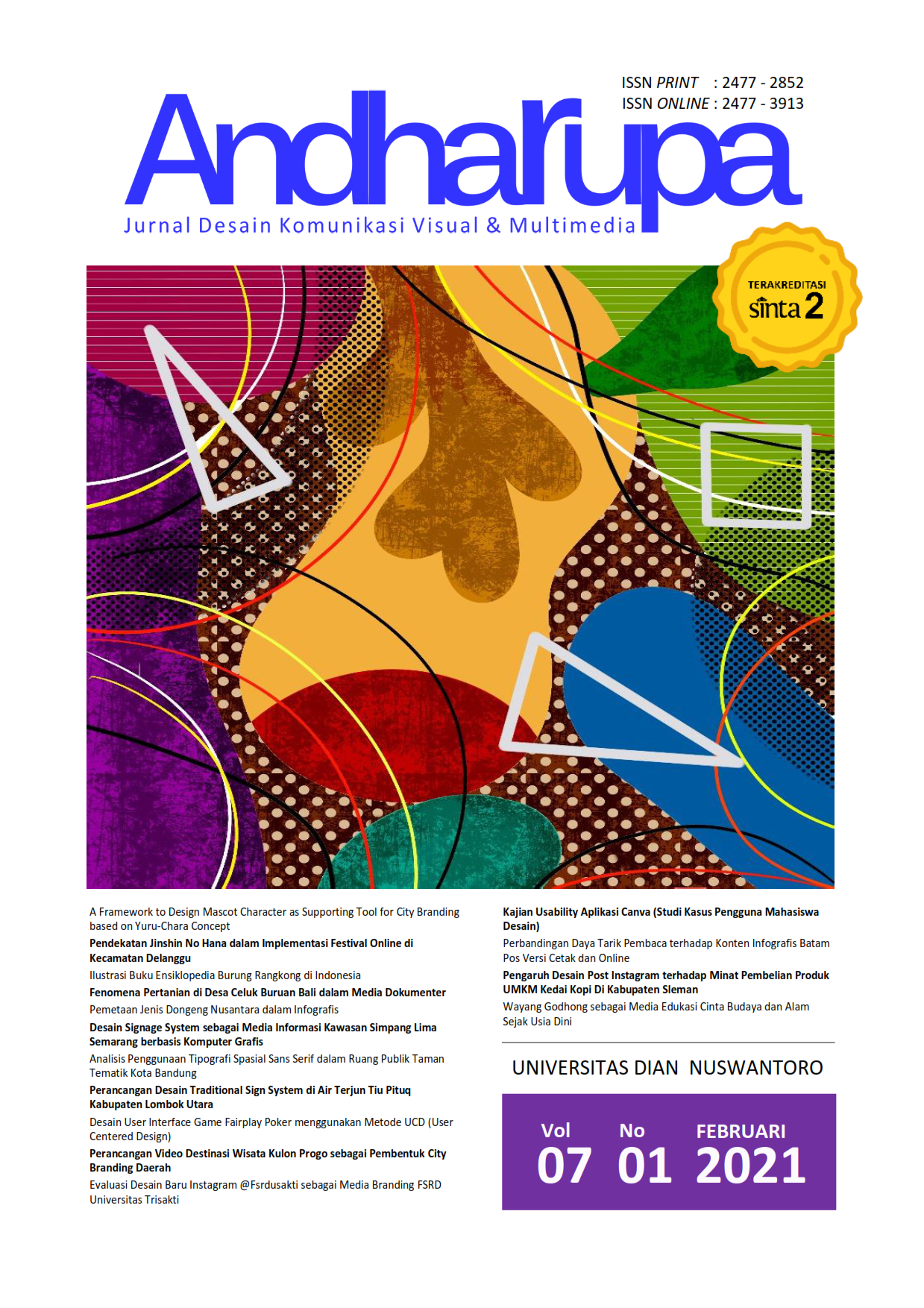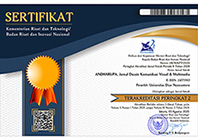PEMETAAN JENIS DONGENG NUSANTARA DALAM INFOGRAFIS
DOI:
https://doi.org/10.33633/andharupa.v7i01.3938Abstract
AbstrakDongeng merupakan warisan budaya lisan yang bersifat mendidik sekaligus menghibur. Sebagai warisan budaya lisan, keberadaan dongeng wajib dilestarikan agar tidak punah. Pada kenyataannya, generasi Z (Gen Z) Indonesia memiliki jarak dengan dongeng. Hal ini diketahui melalui kuesioner yang dibagikan kepada 70 siswa sekolah dasar kelas 3, 4, dan 5. Menurut responden dongeng hanya diketahui melalui pelajaran Bahasa Indonesia. Selain itu, responden tidak mengetahui secara pasti jenis-jenis dongeng nusantara. Penelitian ini bertujuan untuk memantik perhatian (awareness) Gen Z Indonesia terhadap jenis-jenis dongeng nusantara. Pendekatan dilakukan melalui bentuk infografis yang diasumsikan dapat mempermudah Gen Z Indonesia dalam memperoleh informasi, memahami hingga menyadari adanya dongeng. Metode yang digunakan dalam penelitian adalah metode campuran. Hasil pendekatan kuantitatif melalui kuesioner kemudian dianalisa dan dikonfirmasi ulang melalui wawancara dengan para responden melalui pendekatan kualitatif. Hasil wawancara menjadi rujukan dalam mengolah data menjadi pemetaan jenis-jenis dongeng nusantara ke dalam bentuk infografis. Selanjutnya infografis peta jenis dongeng nusantara diujicobakan melalui diskusi dengan kelompok responden yang terdiri dari generasi Z yang dipilih secara acak. Meskipun hasil yang didapat belum optimal, namun simpulan awal dari penelitian ini adalah generasi Z Indonesia mulai memperhatikan (aware) berbagai jenis dongeng nusantara sebagai warisan budaya lisan bangsa Indonesia yang harus dilestarikan. Kata Kunci: generasi Z, infografis, dongeng nusantara, pemetaan AbstractFairy tales are a verbal cultural heritage that is educating and entertaining. As a verbal cultural heritage, fairy tales' existence must preserve so as not extinct. In reality, Indonesian generation Z (Gen Z) has a distance from fairy tales. It's known through a questionnaire distributed to 70 elementary school students in grades 3, 4, and 5. According to them, fairy tales are known only through Bahasa Indonesia subjects. Besides, they do not know for sure the types of Indonesian archipelago fairy tales. This research aims to arise Indonesian Gen Z awareness towards the types of Indonesian archipelago fairy tales. The approach taken through the form of infographics is assumed to facilitate the Indonesian Gen Z in obtaining information, understanding, and being aware of Indonesian fairy tales. The method used in this study is a mixed-method. The quantitative approach research through a questionnaire was then analyzed and reconfirmed through interviews with respondents with a qualitative approach. The interview results referred to processing the data into mapping the types of tales of the Indonesian archipelago into infographics. Furthermore, the Indonesian archipelagos fairy tale type of infographic map was tested through a group discussion consist of randomly selected Gen Z respondences. Although the result not optimal, the early conclusion indicates that Indonesian Gen Z starting to become aware of the Indonesian archipelago fairy tales as the verbal cultural heritage of Indonesia that must be preserved. Keywords: Z generation, infographic, nusantara folktales, mappingReferences
Bencsik, A., Csikos, G., & Juhaz, T. (2016). Y and Z Generations at Workplaces. Journal of Competitiveness, 8(3), 90–106.
Bencsik, A., & Machova, R. (2016). Knowledge Sharing Problems from the Viewpoint of Intergeneration Management. In ICMLG2016 - 4th International
Conferenceon Management, Leadership and Governance: ICMLG. (2016). Academic Conferences and publishing limited.
Creswell, J.W. (2009). Research Design. California: SAGE.
Danandjaja, J. (1984). Folklor Indonesia: Ilmu Gosip, Dongeng dll. Jakarta: PT Grafiti.
Endaswara, S. (2009). Metodologi Penelitian Folklor. Yogyakarta: Medpress
Elmore, T. (2014). How Generation Z Differs from Generation Y. Retrieved July 01, 2015, fromhttp://growingleaders.com/blog/generation-z-differs-generation-y/.
Howe, N., & Strauss, W. (2000). Millennials rising: The next great generation. New York: Vintage.
Kelle, U., & Erzberger, C. (2017). Metode Kualitatif dan Kuantitatif. Yogyakarta: Cantrik Pustaka.
Lankow, J., Ritchie, J., Crooks, R. (2002). Infografis: The Power of Visual Storytelling. Jakarta: PT. Gramedia Pustaka Utama
Tashakkori, A., & Teddie, C. (2010). Mixed Methodology. Yogyakarta: Pustaka Pelajar.
Thompson, S. (1946). The Folktale. New York: The Dryden Press.
Downloads
Published
Issue
Section
License
Copyright (c) 2021 ANDHARUPA: Jurnal Desain Komunikasi Visual & Multimedia

This work is licensed under a Creative Commons Attribution 4.0 International License.
Authors who publish with this journal agree to the following terms:
- Authors retain copyright and grant the journal right of first publication with the work simultaneously licensed under a Creative Commons Attribution License that allows others to share the work with an acknowledgment of the work's authorship and initial publication in this journal.
- Authors are able to enter into separate, additional contractual arrangements for the non-exclusive distribution of the journal's published version of the work (e.g., post it to an institutional repository or publish it in a book), with an acknowledgment of its initial publication in this journal.
- Authors are permitted and encouraged to post their work online (e.g., in institutional repositories or on their website) prior to and during the submission process, as it can lead to productive exchanges, as well as earlier and greater citation of published work (See The Effect of Open Access).















